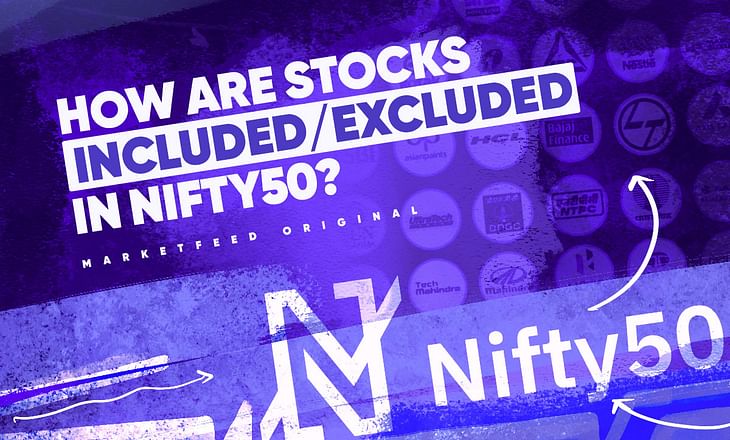How are Stocks Included/Excluded in NIFTY50?

Have you ever wondered how a stock gets added or removed from the NIFTY 50? In this article, find out how the process actually works.
What is NIFTY 50?
The NIFTY 50 is a benchmark stock market index that represents the weighted average of 50 of the largest Indian companies listed on the National Stock Exchange (NSE). The index includes companies that fall under 13 sectors of India’s economy. The index is owned and managed by India Index Services and Products Ltd (IISL). It also manages 67 sub-indices that fall under NIFTY. This includes NIFTY 100, NIFTY Next 50, NIFTY Small Cap, NIFTY Bank, NIFTY IT, etc.
The NIFTY 50 is computed using a free-float market capitalisation weighted method. In simple terms, the level of the index reflects the total market value of all the stocks included in the NIFTY 50, relative to a particular base period. The base period has been fixed as November 3, 1995, which marks the completion of one year of operations of NSE's Capital Market Segment. The base value of the index has been set at 1,000, and a base capital of Rs 2.06 lakh crore.
Criteria for Including/Excluding a Stock in the NIFTY 50
The NIFTY 50 index goes through a reconstitution/rebalancing process every six months (semi-annually). This means that the list of companies included in the NIFTY 50 keeps changing with time. IISL has constituted an Index Maintenance Subcommittee (IMS), which checks the performance of each stock included in the index and also its sub-indices. The IMS makes all decisions on inclusions and exclusions in the index. Let us understand the eligibility criteria for a company to be included in the NIFTY 50:
- It must be an Indian company registered with the NSE.
- The company’s stock must be highly liquid (must have a large number of buyers and sellers). This is measured by the average impact cost. Impact cost is the trading price of single security in relation to the index’s weight to the company’s market capitalisation. (We shall understand this concept briefly later in the article). The stock should have traded at an average impact cost of 0.50% or less during the last six months for 90% of the observations, for a portfolio of Rs 10 crore.
- For the last six months, the company’s trading frequency should be 100%. As the name suggests, trading frequency is the number of trades executed in a specific time interval.
- The company’s average free-float market capitalisation should be at least 1.5 times greater than that of the smallest company on the index. Using the free-float method, market capitalisation is calculated by taking the company’s stock price and multiplying it by the number of shares readily available in the market.
- Shares of the companies that have Differential Voting Rights (DVR) can also be eligible for the NIFTY 50 Index. Companies issue DVR shares to prevent any hostile takeover or dilution of voting rights. DVR shares are offered with superior, lower, or fractional voting rights to public investors. You can read more about DVR shares here.
A list of new eligible stocks is reviewed against the current index constituents twice a year. In case any changes are to be made, then the smallest constituents are excluded from NIFTY50, and new stocks replace them. The index also goes through a reconstitution process when a company undergoes mergers or acquisitions, suspensions, compulsory delisting, etc. The IISL conducts quarterly screening of the companies to keep track of whether they are adhering to all regulations.
What is Impact Cost?
Impact cost is the cost a buyer or a seller incurs while executing a transaction. This cost is dependent on the existing market liquidity. In other words, it represents the cost of executing a transaction of a given security, with a specific predefined order size, at any given point in time. Liquidity in the context of stock markets means a market wherein large orders can be executed without incurring a high transaction cost. Let us look at an example of impact cost:
Suppose a buyer wants to purchase 3,000 shares of a company named XYZ. If the best buy order for 1,000 shares is placed at Rs 127 and the best sell order for 1,500 shares is placed at Rs 129, the ideal price for the deal should be (127+129) ÷ 2 = Rs 128. At this price, one can expect the buyer to ideally get the desired quantity of XYZ shares.
| Buy Quantity | Buy Price | Sell Quantity | Sell Price |
| 1000 | 127 | 1500 | 129 |
| 1500 | 128 | 1000 | 130 |
| 800 | 129 | 1200 | 131 |
However, suppose that the buyer was able to buy the 3,000 shares of XYZ at an average cost of Rs 129.5. This was calculated as [(1500 x 129) + (1000 x 130) + (500 x 131)] ÷ 3000 = 129.67. So, the impact cost will now be calculated as the following:
(Actual Cost - Ideal Cost) ÷ Ideal Cost x 100
(129.67- 128) ÷ 128 x 100 = 1.3%
This is the cost that buyers incur due to a lack of market liquidity. An important point to be noted here is that the impact cost varies for different transaction sizes. In the above example, an investor could end up incurring a high impact cost while buying large quantities of shares.
Now you know how stocks are added and removed in the NIFTY50! As per reports, Indian Oil Corp (IOC) holds a good chance of being excluded from the index. In its place, Apollo Hospitals or Info Edge (Naukri) may be added next year.


Post your comment
No comments to display